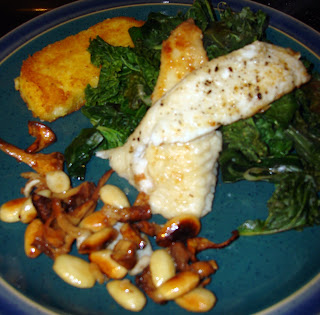Beauty in the Buttermilk
What do you do when someone gives you a quart of buttermilk? Seriously - think about it. Those of you that said “Um, leave it in the fridge to go bad” will now have a better option!
As you may have ascertained, I was recently given a quart of buttermilk. Not just any buttermilk; Animal Farm Buttermilk that was picked up at Saxelby’s in Essex Market. Now this particular buttermilk is a little thinner than some other buttermilks that I have come across in the past, but never fear! The results it gives in culinary application are scrumptious.
They have a lovely recipe for Buttermilk Waffles on this page.
Let’s free associate for a second. Buttermilk.
Biscuits!
Pancakes!
Crème Fraiche!
I have three distinct biscuit recipes in my library: the southern breakfast biscuit, the New England soup biscuit and the “little” biscuit.
“Little” biscuits don’t have to be little, but they are just so darn cute when you make them small for hors d’oeuvres. Smear on butter or jam, stuff with a slice of a sausage link, dunk in a bowl of soup or serve with a soft cheese; this biscuit won’t crumble apart. Originally, this biscuit recipe was used for large sandwich-sized biscuits, delightful for pairing with a piece of fried chicken. Make them large, make them small, make them large and small (you daredevil you), you are still a winner.
Buttermilk Biscuits (15 large, 45 small)
12 oz All-Purpose Flour
12 oz Pastry Flour
11 oz Butter, diced into tiny pieces and frozen
1.25 oz Baking Powder
.5 oz Salt
.5 oz Sugar
16 oz Buttermilk
3 oz Herb of your Choice (Optional)
Important Notes! ( I don’t know about you but I hate it when the chef has hidden the secrets to making the recipe work after all the other directions. Seriously, how many of us read the directions ALL the way through first?) Note: Before starting this recipe, measure out all the ingredients and put everything except herbs and buttermilk in the freezer. If you can, put out the food processor and/ or mixing bowl too. The colder you can keep the ingredients the better it will turn out.
1) Mix all dry ingredients together. THIS DOES NOT MEAN BUTTER (or Herbs). If you have a sifter, use it! If you have a food processer, pulse, pulse, pulse.
2) Add the frozen butter and continue to pulse the food processor until all the chunks are pulverized. If the butter is smearing the sides of the bowl, it is too warm. If you don’t have a food processor, borrow one. In fact: buy one.
3) Transfer the mix into a bowl or stand mix and stir in buttermilk and herbs. Consistency will vary with different types of buttermilk. If it seems really loose (and it may if you use the Animal Farm buttermilk) then stick it back into the refrigerator for 30 minutes before moving onto Step 4. If it is doughy, proceed to Step 4. If it is a powdery mess, re-check your measurements.
4) Spoon out biscuits onto cookie tray and bake at 350 F. If you dip the spoon in flour between scoops it will come away easier. OR: on a well-floured surface, use a flour dusted rolling pin and gently roll out the dough. Use a flour-dipped cookie cutter to form the raw biscuits.
5) Watch for the bottoms of the biscuits to start turning brown at the edges. This is the best indicator that the biscuit is almost done without being burnt. If the top is still completely white and the bottom is browning beautifully, don’t be afraid to flip those bad boys over!
 |
Here we have the finished biscuits with the quart container of frozen ingredients. Just add buttermilk! |
Now, this recipe makes a ton of the little baby biscuits. I like to make the dry ingredients, mix them together and then store half the mixture for another day. In fact, you can cut up the butter and put it in the same container and store it in the freezer. Or you can finish the dough, cut it out, and freeze the pieces on a sheet tray instead of putting them in the oven. That will allow you to bake off the biscuits as you need them. And trust me, you will need 4 a day until you run out of dough.
 |
| Punched out frozen raw biscuit. |
























